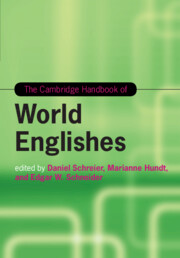Book contents
- The Cambridge Handbook of World Englishes
- Cambridge Handbooks in Language and Linguistics
- The Cambridge Handbook of World Englishes
- Copyright page
- Dedication
- Contents
- Figures
- Maps
- Tables
- Notes on Contributors
- 1 World Englishes: An Introduction
- Part I The Making of Englishes
- Part II World Englishes Old and New
- Part III Linguistics and World Englishes
- 14 The Global Growth of English at the Grassroots
- 15 Beyond English as a Second or Foreign Language: Local Uses and the Cultural Politics of Identification
- 16 World Englishes in Cyberspace
- 17 World Englishes and Their Dialect Roots
- 18 Lexicography and World Englishes
- 19 The Relevance of World Englishes for Variationist Sociolinguistics
- 20 Multilingualism and the World Englishes
- 21 Unearthing the Diachrony of World Englishes
- 22 Corpus-Based Approaches to World Englishes
- 23 World Englishes from the Perspective of Dialect Typology
- 24 Language Acquisition and World Englishes
- Part IV Current Challenges
- Index
- References
23 - World Englishes from the Perspective of Dialect Typology
from Part III - Linguistics and World Englishes
Published online by Cambridge University Press: 16 December 2019
- The Cambridge Handbook of World Englishes
- Cambridge Handbooks in Language and Linguistics
- The Cambridge Handbook of World Englishes
- Copyright page
- Dedication
- Contents
- Figures
- Maps
- Tables
- Notes on Contributors
- 1 World Englishes: An Introduction
- Part I The Making of Englishes
- Part II World Englishes Old and New
- Part III Linguistics and World Englishes
- 14 The Global Growth of English at the Grassroots
- 15 Beyond English as a Second or Foreign Language: Local Uses and the Cultural Politics of Identification
- 16 World Englishes in Cyberspace
- 17 World Englishes and Their Dialect Roots
- 18 Lexicography and World Englishes
- 19 The Relevance of World Englishes for Variationist Sociolinguistics
- 20 Multilingualism and the World Englishes
- 21 Unearthing the Diachrony of World Englishes
- 22 Corpus-Based Approaches to World Englishes
- 23 World Englishes from the Perspective of Dialect Typology
- 24 Language Acquisition and World Englishes
- Part IV Current Challenges
- Index
- References
Summary
Linguistic typology is concerned with classifying human languages and with identifying structural similarities and differences between these languages. Dialectology is the study of typically vernacular and regionally restricted and/or distinctive forms of language. Dialect typology focuses on the intersection between typology and dialectology. In this chapter, we (1) review the set of language-external factors (variety type, world region, exposure to contact) that has been used to categorize World Englishes, (2) summarize the literature about (vernacular) universals, angloversals, and related notions in World Englishes, and (3) discuss work on parameters of structural diversity in World Englishes (analyticity versus syntheticity, complexity versus simplicity).
Keywords
- Type
- Chapter
- Information
- The Cambridge Handbook of World Englishes , pp. 534 - 558Publisher: Cambridge University PressPrint publication year: 2020
References
- 2
- Cited by



